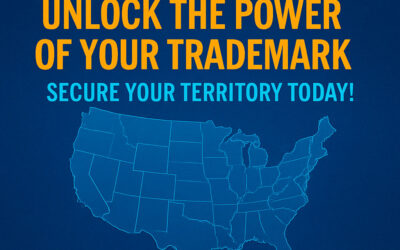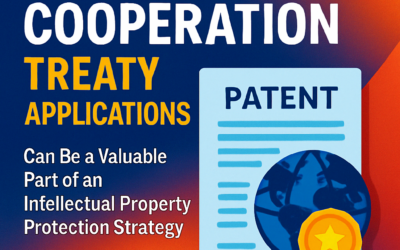[A federal trademark registration should protect the most immediately recognizable pieces of your brand. However, if you select your upcoming brand poorly you may end up with weak or no potential federal trademark protection. Selecting branding that cannot be protected with federal trademark registrations results in reduced return on investment from all of your marketing and sales efforts.
When brand selection is done right, it becomes possible to obtain federal trademark protection and the brand becomes a valuable company asset. When you think of your own favorite businesses and brands, your mind undoubtedly goes straight to the name of the company, the familiar logo, or even a related slogan. The Nike brand, for example, uses the famous check mark logo with the catchphrase, “Just do it.” You’d be hard pressed to find a person who doesn’t immediately recognize Nike’s brand. That is the power of a trademark.
Understanding how best to select your brand and protect your intellectual property is difficult when you’re faced with seemingly endless legal terminology, rules, and paperwork. You need to be sure that your trademark is distinct and not too similar to anyone else’s trademark. This is why it is absolutely necessary when beginning the trademark process to seek out the attorneys of Garcia-Zamor. Our decades of trademark experience will leave you with less stress and more time to focus on your brand.
When it comes to categories of trademarks, there are actually several different types. Some categories offer strong and solid protection, while others are considered weak and unlikely to be registrable. As you plan, take a look at the 5 different trademark types below to help determine the strongest category from which to select your brand:
Fanciful Marks
Fanciful marks offer the highest degree of protection, because they are nonsensical and difficult to imitate. Google is a great example of a fanciful trademark, at least originally. It’s completely made-up and not found in the dictionary. The only problem with these kinds of marks is that they will require more marketing upfront than a mark that clearly relates to your brand and your product. However, the strength of the protection you get in return might just be worth the extra advertising expense.
Arbitrary Marks
Arbitrary marks are also incredibly strong trademarks. Because arbitrary remarks are made of actual, recognized words, they are usually easier for the general public to remember. However, just as with fanciful marks, it is your marketing that will help them to associate the known word with your specific brand. Apple is a well-known example of an arbitrary trademark. It is a real word, but apples have nothing to do with computers or other electronics. Fanciful and arbitrary marks, because of their distinctiveness, are considered to be the most easily protected and strong trademarks. Unfortunately, because of the marketing involved for new brands, they aren’t usually the first choice for startups looking to trademark their product branding.
Suggestive Marks
While suggestive marks aren’t as easily protected as fanciful or arbitrary trademarks, they are still considered to be strong choices. Suggestive marks are whimsical and don’t completely describe a brand’s services or products, but they aren’t nonsense or random words, either. Suggestive marks creatively link to the brand in some way. Take, for example, Netflix. The use of the word “flix” in the name suggests a connection to the movies, while “net” suggests the Internet, but the product still isn’t fully described.
Suggestive trademarks are often preferred by new brands, because the use of subtle suggestion can make the brand at least slightly easier to market. It might be a good idea to come up with separate ideas for fanciful, suggestive, and arbitrary marks. You can sit down with your Garcia-Zamor attorney and decide on which mark is ultimately best for your particular situation.
Descriptive Marks
Descriptive marks are usually an instinctual choice by new merchants or service providers looking to make their brand instantly recognizable. They are thought to be easier to advertise, but descriptive marks are actually weak trademarks. The main rule about trademarks is that they have to be distinctive. Descriptive marks have a hard time meeting that requirement, because they aren’t particularly unique. A trademark like All Natural Foods, for example, is too descriptive to be a registered trademark. Transforming the faux trademark All Natural Foods into something like Newton’s Naturals, a suggestive mark, or NewNau, a fanciful mark, would be far more likely to receive approval from the trademark office. Remember, if you do not have brands that are protected by federal trademark registrations then you are foregoing valuable company assets. Additionally, your competition will be able to imitate your brands and may have an easier time putting you out of business.
If a brand is determined to use a descriptive trademark that the trademark office doesn’t deem distinctive enough, that brand must proceed to demonstrate in some way that their trademark really is unique to them and their product in the eyes of the public in order to be approved. This isn’t an easy feat, particularly for small businesses, and it can become extremely expensive. An example of a descriptive mark in the marketplace today is Southwest Airlines. Obviously, this works for them, but it’s because they were able to prove a level of consumer awareness that warranted the descriptive trademark.
The fear with using a descriptive trademark is that you could end up spending all of this time and money to market your brand only for the trademark office to never approve that mark. You’d then end up having to completely rebrand with a different trademark, costing more money and confusing customers.
Generic Marks
Generic trademarks are, by definition, not distinctive to your brand and therefore cannot be trademarked. You can’t have a t-shirt brand named Shirts, for example.
Unfortunately, there are many cases where a trademark was once original and went on to become so widespread that it is now generic. Flip Phone, for instance, used to be a trademark of Motorola. Of course, we now think of flip phones as an all-encompassing word for a certain style of phones that preceded smartphones. The Motorola Flip Phone trademark ended up being cancelled as a result.
This kind of story also serves as a reminder of the importance of enforcing and monitoring your trademark. This is another area where Garcia-Zamor will assist you. We offer Tradeguard, a monthly monitoring service that tracks your brand’s use and is ready to defend your trademark.
Don’t Settle for Less When It Comes to Trademark Protection
Garcia-Zamor performs essential trademark research to ensure your brand’s protection in the marketplace. Contact the trademark experts at Garcia-Zamor today to protect your most important property — your intellectual property.







